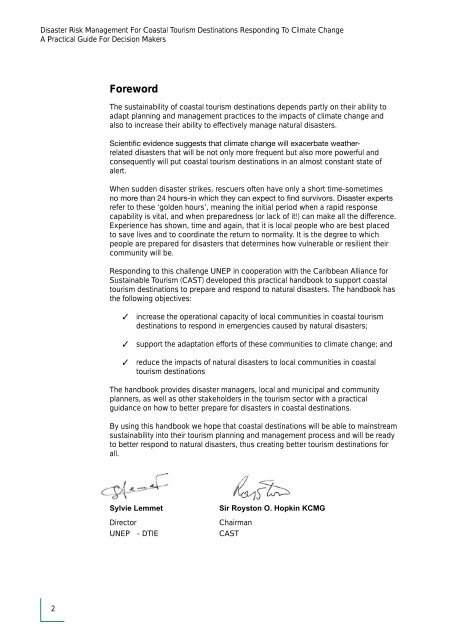Disaster Risk Management For Coastal Tourism Destinations - DTIE
Disaster Risk Management For Coastal Tourism Destinations - DTIE
Disaster Risk Management For Coastal Tourism Destinations - DTIE
Create successful ePaper yourself
Turn your PDF publications into a flip-book with our unique Google optimized e-Paper software.
<strong>Disaster</strong> <strong>Risk</strong> <strong>Management</strong> <strong>For</strong> <strong>Coastal</strong> <strong>Tourism</strong> <strong>Destinations</strong> Responding To Climate Change<br />
A Practical Guide <strong>For</strong> Decision Makers<br />
<strong>For</strong>eword<br />
The sustainability of coastal tourism destinations depends partly on their ability to<br />
adapt planning and management practices to the impacts of climate change and<br />
also to increase their ability to effectively manage natural disasters.<br />
<br />
related disasters that will be not only more frequent but also more powerful and<br />
consequently will put coastal tourism destinations in an almost constant state of<br />
alert.<br />
When sudden disaster strikes, rescuers often have only a short time-sometimes<br />
<br />
refer to these ‘golden hours’, meaning the initial period when a rapid response<br />
capability is vital, and when preparedness (or lack of it!) can make all the difference.<br />
Experience has shown, time and again, that it is local people who are best placed<br />
to save lives and to coordinate the return to normality. It is the degree to which<br />
people are prepared for disasters that determines how vulnerable or resilient their<br />
community will be.<br />
Responding to this challenge UNEP in cooperation with the Caribbean Alliance for<br />
Sustainable <strong>Tourism</strong> (CAST) developed this practical handbook to support coastal<br />
tourism destinations to prepare and respond to natural disasters. The handbook has<br />
the following objectives:<br />
<br />
<br />
<br />
increase the operational capacity of local communities in coastal tourism<br />
destinations to respond in emergencies caused by natural disasters;<br />
support the adaptation efforts of these communities to climate change; and<br />
reduce the impacts of natural disasters to local communities in coastal<br />
tourism destinations<br />
The handbook provides disaster managers, local and municipal and community<br />
planners, as well as other stakeholders in the tourism sector with a practical<br />
guidance on how to better prepare for disasters in coastal destinations.<br />
By using this handbook we hope that coastal destinations will be able to mainstream<br />
sustainability into their tourism planning and management process and will be ready<br />
to better respond to natural disasters, thus creating better tourism destinations for<br />
all.<br />
Sylvie Lemmet<br />
Sir Royston O. Hopkin KCMG<br />
Director<br />
Chairman<br />
UNEP - <strong>DTIE</strong> CAST<br />
2

















